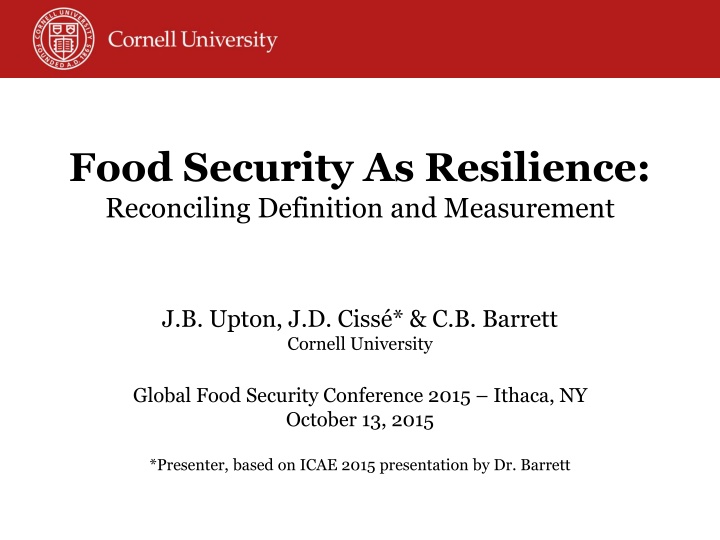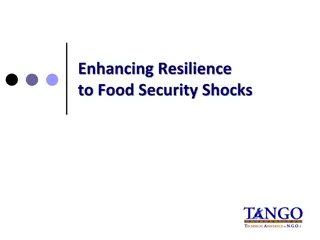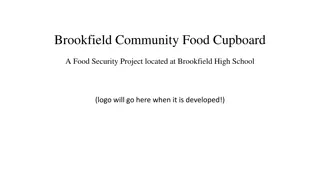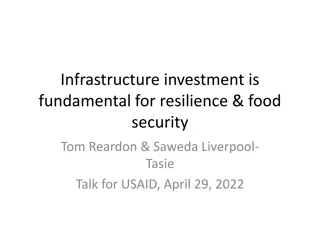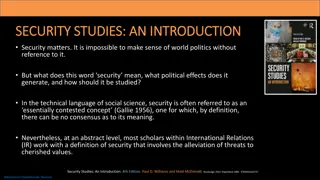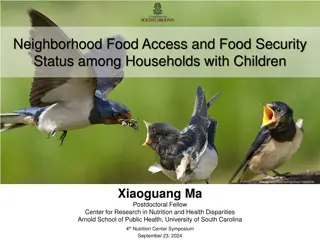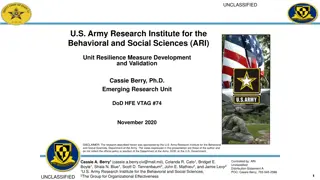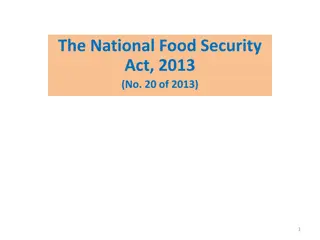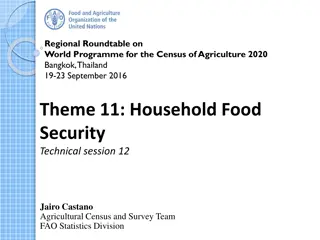Challenges in Defining and Measuring Food Security for Resilience
Food security is crucial, yet challenging to measure due to its intrinsic nature. This presentation highlights the importance of accurate measurements based on agreed-upon definitions. Despite decades of efforts, existing metrics fall short of capturing food insecurity in line with the internationally accepted definition. The quest for effective measurement methods continues to be a significant focus in the realm of global food security.
Download Presentation

Please find below an Image/Link to download the presentation.
The content on the website is provided AS IS for your information and personal use only. It may not be sold, licensed, or shared on other websites without obtaining consent from the author.If you encounter any issues during the download, it is possible that the publisher has removed the file from their server.
You are allowed to download the files provided on this website for personal or commercial use, subject to the condition that they are used lawfully. All files are the property of their respective owners.
The content on the website is provided AS IS for your information and personal use only. It may not be sold, licensed, or shared on other websites without obtaining consent from the author.
E N D
Presentation Transcript
Food Security As Resilience: Reconciling Definition and Measurement J.B. Upton, J.D. Ciss * & C.B. Barrett Cornell University Global Food Security Conference 2015 Ithaca, NY October 13, 2015 *Presenter, based on ICAE 2015 presentation by Dr. Barrett
Before there were evaluations of anti- poverty programs, or analysis of inequality trends, or really most of empirical development economics, there had to be something more fundamental: measurement. We had to know how to assess poverty, and we needed to have large-scale data to do so, to challenge our assumptions, and provide new answers. - Chris Blattman, FP 10/12/15
Motivation Food security matters Measurement matters Difficult to measure something intrinsically unobservable Must be based on agreed-upon definition
Definition Food security exists when all people at all times have physical, social, and economic access to sufficient, safe and nutritious food that meet their dietary needs and food preferences for an active and healthy life. - World Food Summit, 1996
Decades of grappling with measurement Different metrics have different goals Reflect 1 or more observable dimensions Combine dimensions using indices No existing measure well captures food insecurity per internationally agreed definition
Food security exists when all people at all times have physical, social, and economic access to sufficient, safe and nutritious food that meet their dietary needs and food preferences for an active and healthy life.
Food security exists when all people at all times have physical, social, and economic access to sufficient, safe and nutritious food that meet their dietary needs and food preferences for an active and healthy life.
Food security exists when all people at all times have physical, social, and economic access to sufficient, safe and nutritious food that meet their dietary needs and food preferences for an active and healthy life.
FS Measurement Axioms 1. all people the scale axiom(address both individuals and groups at various scales of aggregation) 2. at all times the time axiom (assess stability, given both predictable and unpredictable variation)
Food security exists when all people at all times have physical, social, and economic access to sufficient, safe and nutritious food that meet their dietary needs and food preferences for an active and healthy life.
Food security exists when all people at all times have physical, social, and economic access to sufficient, safe and nutritious food that meet their dietary needs and food preferences for an active and healthy life.
Food security exists when all people at all times have physical, social, and economic access to sufficient, safe and nutritious food that meet their dietary needs and food preferences for an active and healthy life.
FS Measurement Axioms 3. physical, social, and economic access the access axiom (must control for poverty, institutions, infrastructure) 4. an active and healthy life the outcomes axiom (nutrition/health outcome indicators are the ultimate targets)
Data Challenges Shortcomings in national-level data and also in household data Consistency over time Cost Location BUT new data sources & tech emerging
8 7 3 6 5 2 1 4 Larger size indicates better representation of the access axiom Darker color indicates better reflection of the outcomes axiom
8 Tradeoffs 7 3 6 5 2 1 4 Larger size indicates better representation of the access axiom Darker color indicates better reflection of the outcomes axiom
A Development Resilience Approach? Barrett & Constas (PNAS 2014) Probabilistic approach dynamic well- being measurement Moments-based
Addressing Axioms Time axiom (short and long term dynamics Scale axiom (estimate for individuals/ households but aggregable to larger groups)
Addressing Axioms Access axiom (conditioning on economic, physical, or social characteristics) Outcomes axiom (outcomes are either proxy or direct indicators of health/nutrition status)
Example Northern Kenya 924 households, 5 annual rounds Data collected by ILRI to assess impacts of Index Based Livestock Insurance Period encompasses a massive drought (2011) Data: livestock holdings, expenditures, food consumption, child anthropometry, environmental conditions
Process Procedure by Ciss & Barrett (in progress) Normative judgements Level Minimum acceptable standard of adequate well-being (the outcome) for an individual or household. Probability Minimum acceptable likelihood of meeting level
Process Individual child MUAC -1 SD by WHO SDs HDDS mean of upper 1/3 of sample (per FANTA III) We set ? 0.25 but then test alternative levels
Step 1 Estimate the conditional mean MUAC and HDDS equations, conditioned on: Lagged well-being (MUAC/HDDS) in cubic polynomial to allow for nonlinear path dynamics A range of access indicators wealth (TLUs), location, demographics, etc. OLS w/robust standard errors.
Step 2 Capture residuals and estimate conditional variance similarly. Assume normality for simplicity in illustration
Step 3 Use predicted conditional mean and conditional variance to estimate conditional cdf for each child (MUAC) or HH (HDDS), categorize as food secure if ?(? W) 0.25.
Takeaways & Next Steps Measurement is important Must respect the definition Development Resilience Approach may hold promise wrt meeting axioms Need to improve data availability (Headey & Barrett PNAS 2015 on sentinel sites)
Thank You! Email jdc358@cornell.edu Twitter @jenncisse
return Moments-based Describe stochastic well-being dynamics (in reduced form) with moment functions: mk(Wt+s | Wt, Xt, t) where mk represents the kth moment (e.g., mean (k=1), variance (k=2), etc.) Wt is well-being at time t Xt is vector of conditioning variables at time t t is an exogenous disturbance (scalar or vector)
